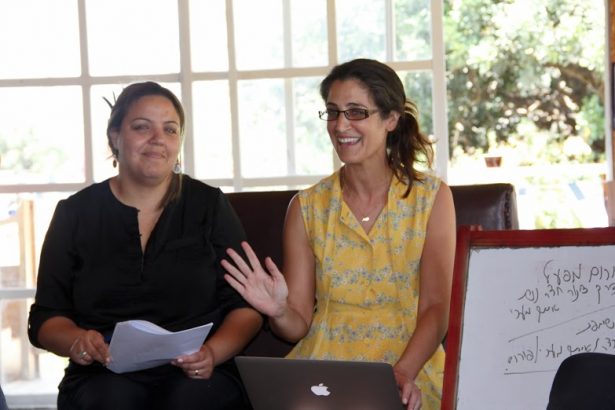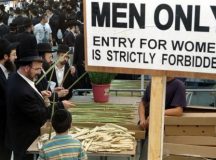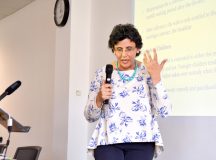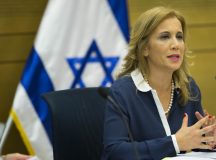Mahapach-Taghir is a grassroots, feminist, Jewish-Arab organisation that works for social change through education and empowerment in marginalised communities in Israel. Co-directors Fida Nara and Sarit Larry spoke to Fathom editor Professor Alan Johnson about the origins of the organisation, its philosophy and practice, and the challenges it faces today.
Origins and Philosophy
Alan Johnson: Fida and Sarit, let’s begin by helping out our English-language readers. What does ‘Mahapach-Taghir’ mean?
Sarit Larry: Yeah, we really made it hard for English-speakers, didn’t we! ‘Taghir’ is the Arabic word for ‘change’. ‘Mahapach’ is Hebrew for ‘revolution’ or ‘radical change’. At first we were only ‘Mahapach’ but in 2006 the Palestinian communities asked: ‘Why is the name of the organisation only in Hebrew, if what we seek is true partnership between Jews and Arabs?’ They decided they wanted to pick an Arabic name and decided ‘Taghir’ best reflected what they are doing.
Fida Nara: ‘Mahapach’ and ‘Taghir’ are two words that complete each other. We need to make a strong change now, but we also need a long-term process at the end of which we have created something new and revolutionary. What is amazing about this organisation is that it brings together Jewish and Arab communities in partnership to work for social change. And when we talk about partnership, we don’t just mean between Jews and Arabs but also between the organisation and the communities we work with. And when we talk about change, we mean change in the organisation itself as well as in those communities.
SL: We began when students at Hebrew University protested against increased tuition fees. They won, felt the power of solidarity and organisation, and wanted to continue as a group fighting for social justice. So they came with big ideas and big ideals to the Katamonim neighbourhood, a peripheral community in Jerusalem. Their attitude was ‘we are here and we know how to help you’. Well, the community responded by saying that it had its own knowledge. Part of what it knew was that the best support these students could give was to provide their children educational support after school. The students talked and said ‘OK, we are going to build a learning centre, it will be free, but in return we ask that you adults participate’. And so the ‘Learning Community’ model was born. What Mahapach-Taghir always asks for is not money but rather the participation of the mothers with a view to empowerment. When the mothers start to participate, they talk, they form a group, slowly they build solidarities, they realise the knowledge that they have, they gather new knowledge, and they start to imagine new projects that they want to create; for example a project to gain access for themselves to university. And then they act. So the local learning community is really a stepping stone into more advanced kinds of activism in the community.
AJ: Can you both say a little about your personal journeys? How did you come to devote your lives to social justice activism and end up co-directing Mahapach-Taghir?
FN: I was active in the feminist community in Palestinian-Arab society inside Israel. I grew up in Neve Shalom – wahat al-Salam, the only Jewish-Arab village in Israel where people choose to live together.
SL: An aside: Arabs and Jews live in the same cities in Israel – but not as a goal and not from choice – Neve Shalom’s goal is co habitation and peace.
FN: After many years of activism in the Arab society, I decided to take a step out of my society in order to explore how we can live and work together here in Israel. So I studied for a Master’s Degree in Gender Studies in Bar-Ilan University and it was there I met Kholod Idris, a board member at Mahapach-Taghir. She told me that Mahapach-Taghir was the perfect place for me because it is all about feminism, community organising and partnership. It’s amazing how things turn out. I don’t know if I would have become a director of Mahapach-Taghir if I had not met her. The job is never easy, and what’s happening in the country today makes it hard. Directing together helps a lot. Sarit and I have a very good partnership.
SL: Thank you Fida, for being so generous. I too think our partnership is really important. I left Israel for something like 10 years and I did not think I would come back. I was disenchanted about the chances for peace and very sad about it. It looked to me like the country wasn’t going in a good direction. I wanted no part of it. (Looking at things today, it seems I was right!) But today I do want a part in it. My journey took me to the US for six years where I completed my PhD in political philosophy, working on the question of how narrative works in radical transformation. And I found that as I was researching and writing, I was slowly gravitating towards coming back to Israel. I became more and more informed about the conflict and I became an activist on campus. I realised that, like it or not, I belonged here in Israel. And since I belong here, it is my responsibility to be part of achieving social change, come what may.
So I came back in 2013 and I have been lucky enough to work in Israeli human rights and social justice organisations, first Gisha and then Mahapach. What I like about Mahapach is that it reaches out to groups that are usually considered natural enemies of each other: the Jewish periphery and the Palestinian-Arab periphery in Israel, both mostly ‘right-wing’ Mizrachi Jewish communities that are very dependent on the state, as are marginalised Palestinian communities in Israel. You see, Fida and I, as a Palestinian and a Jew, we both belong to what is largely considered the ‘middle class’ of the country. Fida grew up in Neve Shalom, a lovely village, and I lived many years in Tel Aviv. Our cooperation is not as rare. Many projects bring together well-to-do Jews and Arabs. Not enough but many. What is rare is to show that it is possible to bring the periphery communities together. And that’s the great hope. As a citizen, this work is very fulfilling. It gives me great strength to work in an organisation that insists on holding onto social hope.
Critical Pedagogy
AJ: Let’s talk about the distinctive philosophy of the organisation. Mahapach-Taghir has three foundational commitments – to critical pedagogy and community activism, to feminism and to Jewish-Palestinian Partnership. It’s a fascinating combination and I’d like to talk about each. First, what is critical pedagogy and why is it so important to Mahapach-Taghir? I get the sense that critical pedagogy isn’t just a way of teaching inside the classroom, but has a much wider meaning.
SL: Yes, critical pedagogy is always about transgressing. It takes ‘education’ to mean the empowerment of the students in ways that are relevant to their lives. At Mahapach-Taghir the word that connects all the things that we do is power. We think education is about empowerment. It’s about helping people to realise where they are standing and why they are standing there, as well as grasping which structures put you there and how might you respond to them. Should you avoid those structures? Should you try to change them, and if so, should you do so from within or from the outside?
We believe that community organising is also a way to empower. For example, we can live in a neighbourhood and think that we can do nothing to improve our lives. But then we write a letter and a hundred people sign it and suddenly things look different, we are in a different position vis-a-vis the structures around us. At the heart of what we do is partnership, working to increase the power of the marginalised and weak in order to change the world around us.
Feminism
AJ: Mahapach-Taghir proudly declares itself to be ‘at its core, a feminist organisation based on feminist principles’. What are those principles, for you, and in what ways do they shape the organisation? Is feminism about who you organise with, how you organise, what you organise for?
FN: It’s all that, but sometimes none of that. It depends on what came from the community to begin with. We have red lines of course, things we won’t do, but mostly whatever a community identifies as its need, we will try to meet that. We work with everyone who comes to one of our learning centres, which we have in each community. Most of the time, the people who came and were active in the education of their children, were the mothers. This fact changed the organisation and made it a feminist organisation. Helping the community to ask questions about itself is our focus. Is the community experiencing a problem? Then we work together to ask what, why, who?
SL: As Fida says, Mahapach-Taghir didn’t start as a feminist organisation; it realised it is a feminist organisation. It started out wanting to organise in weakened communities. Then the students found out that when they asked the parents to come to meetings, it was women who came. And that changed the way that they acted because women face very specific kinds of challenges that prevent them from being more active and women have very specific needs. By working with those challenges and for those needs, the students themselves and the organisation itself were changed. We try to pay very close attention to the communal challenges of women – marginalisation in higher education, or example, as they often feel that they don’t have time because they have so many other responsibilities. So our feminism has been about trying to wear the glasses that allow us to see the challenges faced by these women, who are, by the way, really leaders in their communities. While our staff are all women, we do have male volunteers. And of course we work with men in the community centres; all are welcome. Feminism is for everyone.
Jewish-Palestinian Partnership
AJ: Mahapach-Taghir seeks to promote Jewish-Palestinian partnership. You encourage ‘an alternative discourse that recognises and accepts the narrative of the other, fosters a positive perspective on identity, and encourages inter-community solidarity and partnership based on shared values of human rights’. Can you tell me some of the ways you set about doing that? Also, do you feel that you are swimming against the stream? After all, many Israelis, including most famously President Reuven Rivlin, worry that Israel is breaking up into ‘tribes’ and one hears a lot of incitement against ‘the Other’.
SL: Israel is divided in many ways. Palestinians and Jews can live in the same city and not really be involved in each other’s lives because their children go to different schools and learn different narratives and they enjoy a different kind of status in the society. So anyone saying they are trying to encourage Jewish-Arab partnership is working against the stream. And the stream became stronger during the 2015 election.
The way we work accepts the reality of separation on the ground. We organise within communities that are usually homogenous, either Jewish or Palestinian — they are hardly ever both, because Jews and Palestinians don’t really share a life in Israel, they live separately, even if they are close, as they are in Haifa or in Nazareth Illit – but then we try to bring the communities together.
We build a centre in each of our communities. Each centre starts with the task of empowering the community, not from the task of creating Jewish – Palestinian partnership. Later, we bring the communities together for meetings, planning together, sharing their work, and envisioning together what they want to do in the future. Because they are far away from each other and never mix, we need a lot of resources to bring them together.
We organise the twinning of communities and they learn about each other and about the challenges each faces, some of which they discover are shared. And this creates solidarity. This work of bringing the communities together creates the fabric of life in which the ‘Other’ side is not so different to you, and it creates empathy when the ‘other’ is different from you. In Mahapach we think that the best antidote to racism and xenophobia is sustaining this mutually enjoyed fabric of life.
FN: Let me add two examples. The first is what happened to me the first day I walked into Mahapach-Taghir. We were having a seminar for all our communities and an Orthodox Jewish woman from Jerusalem came to me and said ‘Hi, I hear that you are the new Palestinian co-director of Mahapach-Taghir. I hope that you will have a good time with us’. I was shocked because this was the last woman I thought I would be building a partnership with. But this woman, Galit, accepted my identity and she accepted that this is the way our organisation works, that it has a Palestinian co-director. I’d not seen that attitude in the NGOs I’d been involved in previously.
The other example I want to talk about is an Arab university student who helps Jewish children in our learning centre with their mathematics. The children are learning anti-racism without talking about ‘Arab’ or ‘Jewish’. The children understand that their teacher is a human being just like them and from that they can later start talking about racism and the situation here in Israel. What happens in Israel, it’s not natural for a country. We want to make it more natural. We want to take the example of that teacher and those children and spread it to more and more learning centres in more and more communities. The experience changed the Arab student as well as the Jewish child.
AJ: How do you try to sustain these seeds of Jewish-Palestinian partnership and solidarity at times of conflict such as the last Gaza conflict in 2014?
FN: That was a really hard and difficult time. Nobody talked with the ‘other’. Arab women were afraid to go to Jewish cities. Jewish people were afraid of Arab people. It took time to recover. One month into the conflict, Mahapach-Taghir suggested a meeting in Haifa between the women. It was very difficult for the Arab women, whose families were worried that they may be attacked for wearing the hijab. The Jewish women were told by their families ‘don’t go, they are bad, something bad can happen to you’. Some were then told ‘you are not part of our family!’ Really hard things to hear from your own family. But in the end, it was the women who decided they wanted a meeting.
Not all came but more than 40 brave women met in Haifa. They talked together as mothers and said that they want a better life for their children, without war. It’s a different way to act – to meet, talk, and affirm to each other that we want to continue to work together as Arabs and Jews to change the reality for ourselves and for our children. The women wrote a statement and published it. That was remarkable, given the situation in Israel.
Statement
August 2014
We, at ‘Mahapach-Taghir’ wish to change the rules of the game. We wish to build an alternative that rejects the dichotomy of ‘us’ and ‘them,’ confronts oppression and does not accept it. We come with a proposition for dialogue that creates solidarity between communities. We choose to be partners and not enemies…
Through our pain, worry, fear and anger, we refuse to be helpless. We are not willing to obey orders to be silent, nor will we surrender to silencing. We choose to speak out our diverse voices, to take a stand regarding the separation, racism, hate and violence annihilating our routine life, particularly in times of war. We view all of these elements as part of a long-term discriminatory, institutional policy of neglecting communities in the geographical and social peripheries. In the face of the ‘divide and conquer’ policy of a government that abandons its citizens and incites them against each other, we propose an alternative. Our alternative is discussion and forgiveness based on recognition and respect for every individual’s religious, national and ethnic identity.
When people in the media say bad things about all Jews or all Arabs it really affects the communities. That most women don’t leave the work, but keep going in partnership with each other, keep meeting up in our national forums, is amazing.
SL: To understand just how much it meant for Palestinian women and Jewish women to meet at the time of the Gaza War, despite the incitement that went on in Israel at that time, when it was scary to walk even in Tel Aviv and not to be for the war, is really something you can only know from within. It was an act of great bravery by the women from the Palestinian communities and the Jewish communities. It showed what is possible. Unity and solidarity is less ‘science fiction’ than some people would have you think. At the end of the day, when people meet, they come to understand each other.
The practice of Mahapach-Taghir
Empowerment
AJ: Let’s talk more about this word ‘empowerment’. You say your goal is to help Jewish and Arab women realise that ‘when they come together they have much more power’. Well, in the UK we hear the word ‘empowerment’ so much these days it has become banal, a kind of bureaucratese, its original meaning largely erased. So what do you mean by it? Can you break the word down into concrete experiences, changes and outcomes? Who and/or what denies women access to power in Israel? And how does Mahapach-Taghir ‘empower’ women?
SL: I really like this question! You are right to say that the word is getting a bad rap because it has been overused. For me, empowerment means to identify, to imagine and to act.
First of all, empowerment means to identify the structures of power around you, to identify where and when you are powerless and where and when you have power. For example, you can identify the community as a structure of power and discover that you have power when, previously, you thought you did not. You can reflect on the structures of education around you and understand that you are being made weaker than you should be. And then from these insights may come anger and a determination to do something about it. You can decide you want to resist, or not.
The second thing empowerment means to me is the ability to imagine yourself transgressing the boundaries set for you by others. For example, take ‘Second Opportunity,’ the Mahapach-Taghir project that helps women to follow through their own decision to be in higher education. The moment the women put their foot across that particular boundary, and then pass with flying colours, they don’t just make it possible for other women to imagine themselves in a university; they also help the university to imagine new kinds of students.
The third aspect of empowerment is, of course, to act. Once you have knowledge of structures, and can imagine transgressing those structures, you can begin to discuss what it is you need to do to resist them and to achieve change; or to accept them, if you decide they are good for you. To sum up, empowerment is a process of identification, imagination and action.
FN: I agree with that. That’s exactly what it is. And I want to add: it’s not the case that we already have the knowledge and we give it to communities. What actually happens is that we create spaces where people can come together as a community and start thinking and imagining and acting in concert. This is really important. We are part of that, but a lot of knowledge comes from the community. That’s why, as we said, the communities change the organisation. That’s why we became an Arab-Jewish organisation, and a feminist organisation. It’s not all one – way.
When women in Tamra, an Arab city in the north of Israel, successfully campaigned for the municipality to create scholarships for women to attend university, they demonstrated their power. They instilled the belief in others that they could change their reality too. It’s not just about having the degree. It’s also about knowing that you have the power to ask for all your rights from whoever – the municipality, from the university, or from Mahapach-Taghir.
Solidarity between the Jewish and Palestinian peripheries
AJ: Mahapach-Taghir works to advance solidarity between the Jewish and Palestinian peripheries. For example the Kiriyat Shmona and Maghar communities held a conference titled ‘Sister, Where is the Periphery?’ continuing two years of co-operative work. Can you explain the concept of ‘the periphery’ and tell us how you decide which marginalised communities in Israel to work in, what challenges each presents, and how you then bring the communities together?
SL: ‘Periphery’ is a layered term referring to marginalisation. One can be marginalised in several ways. The periphery refers to those places and people that are marginalised from the main resources in the social and political arena, who are on the receiving end of structures of power. You don’t have to live in the geographical periphery, there are peripheral communities in Tel Aviv – places that receive fewer resources over the years until an atmosphere is created that allows them to reach a certain boundary but not to transgress. But yes, it can also refer to the geographical periphery. Fida spoke of Palestinian women in Jaffa of Nazereth, who wanted a bus. Now a bus service may be nothing in Tel Aviv. In the periphery, a bus can be a miracle. Periphery also refers to gender: women can be marginalised even if they don’t live in the (geographical) periphery.
FN: Being part of the periphery is about being excluded from the power to make decisions. You can live in a big city such as Jerusalem, but a community like Kiryat Hayovel is still far away from the people who make the decisions. And that distance applies especially to women.
SL. Exactly. That’s the best definition.
The Learning Community Project
AJ: In 2016 Mahapach-Taghir won a Human Rights award from the New Israel Fund for its educational work in these peripheral or marginalised communities. You have created the ‘Learning Community’ project in which university students tutor and mentor young people in marginalised neighbourhoods. Can you talk about this project?
FN: Well, this goes back to the roots of the organisation that Sarit discussed earlier. We started as a university student organisation, focused on teaching children after school in marginalised communities. The ‘Learning Centre’ idea emerged from that. It’s free, but the parents should be active as teachers and learners – that’s the basis of the learning centres. When the children saw their mothers active in the centre it was very empowering for them. Sometimes the municipality likes the project and supports it. That happened in Katamonim and Sderot. When municipalities back the project this is a success for us. It means we can open a new community elsewhere because local leaders recognised their responsibility and are in a dialogue with the residents. We want the learning centres to be embedded in the daily life of the neighbourhood.
Second Opportunity Project
AJ: ‘Second Opportunity’ is an educational project run by Mahapach-Taghir which gave 30 Israeli women who had never had the opportunity to pursue higher education. You partnered with Oxfam’s Israeli Civil Society Programme and the Jerusalem Municipality. I watched a video about this project and saw a Palestinian woman said ‘a classroom is a beautiful thing’. (As a former university teacher I thought that was fantastic thing to hear.) Can you tell us why you started the Second Opportunity Project, who participates and what challenges they face?
FN: The Second Opportunity Project grew out of the learning centres. One day the mothers looked at the students and said: ‘We want to be students too.’ And that speaks to what we were talking about earlier: the ability to imagine. Suddenly, into your daily life comes something new. These were 40-year-old women with kids, higher education was not supposed to be for them. But in this space we had created they developed the ability to say something entirely new and to say it together. This struck a chord with us, so negotiations started between The David Yellin Academic College of Education, in Jerusalem, the municipality and the women of Mahapach-Taghir, and a programme suitable for mothers from this community was created. That meant a programme of one day of study each week, not five, help with the children, and scholarships. Thirty-two started and 27 passed. That was incredible. Some went on to do a Master’s degree and do not need Mahapach-Taghir’s help any more.
When the Palestinian women from Tamra heard about the project at one of our national gatherings of all the communities, they said: ‘We also want to do what the Jews are doing!’ So a Second Opportunity Project then started in Tamra. Thirty Palestinian women are now in their fifth semester with the Open University, now a great partner of Mahapach-Taghir. These women negotiated scholarships from their own city, in the municipal budget – incredible work.
Challenges
AJ: What are the main challenges facing Mahapach-Taghir today?
FN: There are a few, but I’d highlight two. One of the most important is to retain a belief in the value of working for long-term change in and with communities. So many NGOs today seek short-term policy change imposed from above. Social change of the kind we seek is hard work, a slow process, and it takes a lot of time before you can see the impacts. Another challenge is the government in Israel, not just as regards its relationship to Palestinians but also to poor people.
SL: We face big systems. Sometimes they become great partners, like the municipalities in Tamra and some of the Florentine municipality workers in Tel Aviv. But the process of partnering up is not an easy one. And I agree with Fida that the reality in Israel is not helpful. It’s a reality of separation, so you are also working against the grain of reality. But I also want to speak about something that might seem trivial — the physical distances between the peripheral communities, and the lack of transportation. Structurally, it’s difficult for the Jewish periphery to meet with the Arab periphery and become part of each other’s lives. It’s hard to get from one place to another. When I want to enable people from Florentine to meet people from Tamra that means generating the resources to ensure affordability. That’s a real challenge.
But we rise to all these challenges. I hope that when people read about our work in Fathom it will inspire them. On a small-scale, our work shows that solidarity between Jews and Palestinians is possible; a shared society is possible, a more egalitarian society is possible. Another Israel is possible.
FN: When more and more communities, Jewish and Arab, meet and know about each other, and work together, we can change the world. Once people believe they can change their reality and get active to create a better life for their families there will be no stopping them.






































100 years of residence of two peoples on a narrow strip of land proved that Jews and Arabs can not and should not live in one country. Every nation must live in its own country.
This is the essence of the UN decision on the partition of Palestine.
ALL Jews were expelled from the Gaza Strip and from areas A and B. It’s time to ALL 6 million Arabs of Palestine to obtain the citizenship of the Palestinian National Autonomy.
Only then will begin economical, political and physical separation between Jews and Arabs.
Without this, peace in Palestine is impossible.